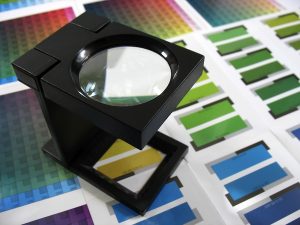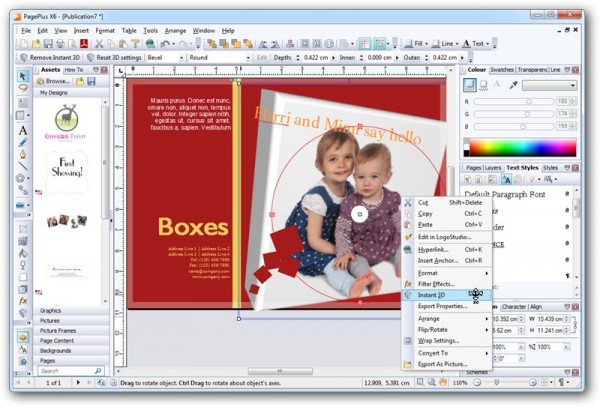 If you’ve not taken a look at Serif’s flagship DTP application of late, then you’ll be pleasantly surprised. It has come leaps and bounds in recent generations, closing the gap to high-end packages like Adobe InDesign and Quark Xpress while managing to retain a sub-$100 price point and remaining beginner-friendly to boot.
If you’ve not taken a look at Serif’s flagship DTP application of late, then you’ll be pleasantly surprised. It has come leaps and bounds in recent generations, closing the gap to high-end packages like Adobe InDesign and Quark Xpress while managing to retain a sub-$100 price point and remaining beginner-friendly to boot.
The question is, can Serif PagePlus X6 continue this fine run of form? What new features does it offer to tempt existing users to upgrade, and does it manage to maintain that perfect blend of power, value and accessibility?
The Basics
Serif PagePlus X6 is, quite simply, a desktop-publishing program. It started out as a beginner-friendly package, lacking the sophistication of other, better-known DTP tools but has evolved at a rapid pace, with a new version appearing pretty much on an annual basis. In recent years, Serif has started to introduce some really high-end, professional-level tools that has lifted PagePlus clear of rival packages like Microsoft Publisher, all while retaining its budget-friendly price point and beginner-friendly user interface.
Although template-driven to give users an easy entry point into the basics of design and layout, PagePlus is also packed with all the design tools a professional would need to start publications from a blank canvas, and the new X6 release builds on PagePlus’s increasingly strong foundations to deliver some really heavy knockout features to lift it to new heights.
Asset Management
The major standout feature in PagePlus X6 is a new Asset Management tab, found to the left of the workspace. This provides you with a neat one-stop shop for reusable elements, and you’ll find plenty provided under the various headings of graphics, pictures, picture frames, page content, background and pages -- just click Browse to access the hundreds of elements based on PagePlus’s templates. Add them to the Asset Management tab, and you can then simply drag them into place on your document.
It’s a two-way process -- you’ll also see a My Assets category, where you can drag elements off the page for reuse. It all adds up to help you in a number of ways: there’s the speed factor of simply dragging elements into place, of course, but it also ensures your designs stay consistent looking. It works superbly, and feels right at home from the off, as if it’s been a part of PagePlus for years.
Cleaner, Better Designs
PagePlus X6 also introduces a new Clean Design Mode. Keep this switched on, and it’ll hide all unnecessary elements like rules and grid lines from view. Obviously they’re there for a reason, which is why when you start dragging elements around the most relevant guides are shown, allowing you to snap your elements into place precisely. If you follow the “less is more” mantra, and find guidelines an unnecessary distraction while working you’ll find it godsend.
PagePlus X6 also embraces the latest digital technologies -- it can now output to both major eBook formats (EPUB and MOBI), while more options for creating interactive, digital magazines in PDF format are also supplied, including the ability to stream video, hide or show elements and new graphical buttons for readers to click.

There’s also a new Preflight Checker, which will verify your documents adhere to strict standards prior to output via HTML, PDF or eBook. It’s a useful tool for those who struggle to stay within the rulebook, and vital if you’re intending to take advantage of the eBook functionality. That’s because PagePlus doesn’t provide much in the way of guidance for eBooks -- there are no dedicated templates for example, and you’ll need to dip into the Help file if you’re not familiar with the strict guidelines you need to follow.
More New Features
Professionals wondering if PagePlus will provide a cheaper, yet viable, alternative to more expensive solutions will no doubt also be pleased to see PagePlus X6 now supports various Pantone standards, including Pantone Plus and Pantone Goe for ensuring colour accuracy.
There are also some useful new graphics tools for those who want to go that little bit further with their designs -- the most notable of these is the Format Painter, which simplifies the process of applying a consistent style across multiple elements on your page.
There are also improvements to the table of contents and index tools via their own dedicated Studio tab, plus templates are now easier to edit, and you can store multiple contact details too. The dictionaries have been revamped -- there are custom hyphenation and abbreviation tools added, for example -- and the unified design, which aims to keep your documents consistent across a variety of platforms, has also been revamped.
One feature we’re glad to see dropped are the standalone web design tools -- although you can still output in HTML, PagePlus X6 has sensibly gone back to concentrating on what it does best: deliver top-notch desktop publishing tools.
Conclusion
All of these new features sit on top of what was already an impressive desktop publishing package. PagePlus manages to comfortably balance high-end tools and support for professional printing standards (its PDF import and export tools are superb, for example) with a user-friendly, simple approach to editing. Much of this comes down to the refined user interface, helped by reasonably intuitive controls and a host of useful tools like LogoPlus, WritePlus and the PhotoLab, which allow you to concentrate on creating and tweaking specific page elements separately from the actual design process.
The new Assets Management tab is a fabulous addition to what was already a compelling package -- if you’re serious about desktop publishing, but can’t afford the outlay of a professional-level tool like Adobe InDesign, then Serif PagePlus X6 won’t disappoint. It’ll also appeal to those who like the idea of desktop publishing, but have always felt a little overwhelmed by the raw power on offer. And if you’re an existing user, the new features and improvements are more than enough to justify an upgrade. It all adds up to an irresistible package, whichever side of the design fence you sit on.
Photo Credit: Adem Demir/Shutterstock

